|
|
Oats: Multi-Beneficial Food for Women

The common oat (Avena sativa) is a species of cereal grain grown for its
seed, which is known by the same name (usually in the plural, unlike other
grains). While oats are suitable for human consumption as oatmeal and rolled
oats.
Oats have numerous uses in food; most commonly, they are rolled or crushed into
oatmeal, or ground into fine oat flour. Oatmeal is chiefly eaten as porridge,
but may also be used in a variety of baked goods, such as oatcakes, oatmeal
cookies, and oat bread. Oats are also an ingredient in many cold cereals, in
particular muesli and granola. Oats may also be consumed raw, and cookies with
raw oats are becoming popular.
Historical attitudes towards oats have varied. Oat bread was first manufactured
in Britain, where the first oat bread factory was established in 1899. In
Scotland, they were, and still are, held in high esteem, as a mainstay of the
national diet.
In Scotland, a dish called cow pat was made by soaking the husks from oats for a
week, so the fine, floury part of the meal remained as sediment to be strained
off, boiled and eaten. Oats are also widely used there as a thickener in soups,
as barley or rice might be used in other countries.
Oats are also commonly used as feed for horses when extra carbohydrates, and the
subsequent boost in energy, are required. The oat hull may be crushed ("rolled"
or "crimped") for the horse to more easily digest the grain, or may be fed
whole. They may be given alone or as part of a blended food pellet. Cattle are
also fed oats, either whole, or ground into a coarse flour using a roller mill,
burr mill, or hammer mill.
Winter oats may be grown as an off-season groundcover and ploughed under in the
spring as a green fertilizer, or harvested in early summer. They also can be
used for pasture; they can be grazed a while, then allowed to head out for grain
production, or grazed continuously until other pastures are ready.
Oat straw is prized by cattle and horse producers as bedding, due to its soft,
relatively dust-free, and absorbent nature. The straw can also be used for
making corn dollies. Tied in a muslin bag, oat straw was used to soften bath
water.
Oats are also occasionally used in several different drinks. In Britain, they
are sometimes used for brewing beer. Oatmeal stout is one variety brewed using a
percentage of oats for the wort. The more rarely used oat malt is produced by
the Thomas Fawcett & Sons Maltings, and was used in the Maclay Oat Malt Stout
before Maclays Brewery ceased independent brewing operations. A cold, sweet
drink called avena made of ground oats and milk is a popular refreshment
throughout Latin America. Oatmeal caudle, made of ale and oatmeal with spices,
was a traditional British drink and a favourite of Oliver Cromwell.
Oat extract can also be used to soothe skin conditions. It is the principal
ingredient for the Aveeno line of products. Oat grass has been used
traditionally for medicinal purposes, including to help balance the menstrual
cycle, treat dysmenorrhoea, and for osteoporosis and urinary tract infections.
Oats are generally considered "healthful", or a health food, being touted
commercially as nutritious. The discovery of their healthy cholesterol-lowering
properties has led to wider appreciation of oats as human food.
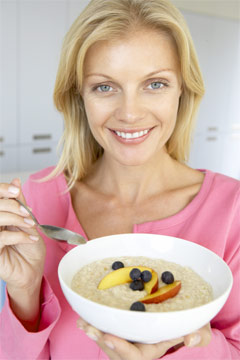 Oat bran is the outer casing of the oat. Its consumption is believed to lower
LDL ("bad") cholesterol, and possibly to reduce the risk of heart disease. Oats
contain more soluble fibre than any other grain, resulting in slower digestion
and an extended sensation of fullness. One type of soluble fibre, beta-glucans,
has been proven to help lower cholesterol. Oat bran is the outer casing of the oat. Its consumption is believed to lower
LDL ("bad") cholesterol, and possibly to reduce the risk of heart disease. Oats
contain more soluble fibre than any other grain, resulting in slower digestion
and an extended sensation of fullness. One type of soluble fibre, beta-glucans,
has been proven to help lower cholesterol.
After reports of research finding that dietary oats can help lower cholesterol,
an "oat bran craze" swept the U.S. in the late 1980s, peaking in 1989, when
potato chips with added oat bran were marketed.
The food fad was short-lived and faded by the early 1990s. The popularity of
oatmeal and other oat products again increased after a January 1998 decision by
the Food and Drug Administration (FDA), when it issued a final rule that allows
food companies to make health claims on food labels of foods that contain
soluble fibre from whole oats (oat bran, oat flour and rolled oats), noting that
3.0 grams of soluble fibre daily from these foods may reduce the risk of heart
disease. To qualify for the health claim, the whole oat-containing food must
provide at least 0.75 grams of soluble fibre per serving. A class of
polysaccharides known as beta-D-glucans comprise the soluble fibre in whole
oats.
Beta-D-glucans, usually referred to as beta-glucans, comprise a class of
indigestible polysaccharides widely found in nature in sources such as grains,
barley, yeast, bacteria, algae and mushrooms. In oats, barley and other cereal
grains, they are located primarily in the endosperm cell wall.
Oat beta-glucan is a soluble fibre. It is a viscous polysaccharide made up of
units of the monosaccharide D-glucose. Oat beta-glucan is composed of
mixed-linkage polysaccharides. This means the bonds between the D-glucose or D-glucopyranosyl
units are either beta-1, 3 linkages or beta-1, 4 linkages. This type of beta-glucan
is also referred to as a mixed-linkage (1?3), (1?4)-beta-D-glucan. The
(1?3)-linkages break up the uniform structure of the beta-D-glucan molecule and
make it soluble and flexible. In comparison, the indigestible polysaccharide
cellulose is also a beta-glucan, but is not soluble. The reason it is insoluble
is cellulose consists only of (1?4)-beta-D-linkages. The percentages of beta-glucan
in the various whole oat products are: oat bran, greater than 5.5% and up to
23.0%; rolled oats, about 4%; and whole oat flour about 4%.
Oats, after corn (maize), have the highest lipid content of any cereal, e.g.,
greater than 10% for oats and as high as 17% for some maize cultivars compared
to about 2-3% for wheat and most other cereals. The polar lipid content of oats
(about 8�17% glycolipid and 10�20% phospholipid or a total of about 33%) is
greater than that of other cereals, since much of the lipid fraction is
contained within the endosperm.
Oats are the only cereal containing a globulin or legume-like protein, avenalin,
as the major (80%) storage protein. Globulins are characterised by solubility in
dilute saline. The more typical cereal proteins, such as gluten and zein, are
prolamines (prolamins). The minor protein of oat is a prolamine, avenin. Oat
protein is nearly equivalent in quality to soy protein, which World Health
Organization research has shown to be equal to meat, milk, and egg protein. The
protein content of the hull-less oat kernel (groat) ranges from 12 to 24%, the
highest among cereals.
 Coeliac disease (celiac disease) is often associated with the ingestion of
wheat, or more specifically, a group of proteins labelled prolamines, or more
commonly, gluten. Oats lack many of the prolamines found in wheat; however, oats
do contain avenin. Avenin is toxic to the intestinal mucosa of avenin-sensitive
individuals, and can trigger a reaction in these coeliacs. Coeliac disease (celiac disease) is often associated with the ingestion of
wheat, or more specifically, a group of proteins labelled prolamines, or more
commonly, gluten. Oats lack many of the prolamines found in wheat; however, oats
do contain avenin. Avenin is toxic to the intestinal mucosa of avenin-sensitive
individuals, and can trigger a reaction in these coeliacs.
The most recent research indicates some cultivars of oat can be a safe part of a
gluten-free diet, because different varieties of oats have different levels of
toxicity. Although oats do contain avenin, several studies suggest this may not
be problematic for all coeliacs. The first such study was published in 1995. A
follow-up study indicated it is safe to use oats even in a longer period.
Additionally, oats are frequently processed near wheat, barley and other grains,
so become contaminated with other glutens. Because of this, the FAO's Codex
Alimentarius Commission officially lists them as a gluten-containing crop. Oats
from Ireland and Scotland, where less wheat is grown, are less likely to be
contaminated in this way. Oats are part of a gluten-free diet in countries like
Finland and Sweden. Suppliers in both those countries offer "pure oat" products.
Health benefits for women
1) Cardiovascular Benefits for Postmenopausal Women
Eating a serving of whole grains, such as oats, at least 6 times each week is an
especially good idea for postmenopausal women with high cholesterol, high blood
pressure or other signs of cardiovascular disease (CVD).
A 3-year prospective study of over 200 postmenopausal women with CVD, published
in the American Heart Journal, shows that those eating at least 6 servings of
whole grains each week experienced both: Slowed progression of atherosclerosis,
the build-up of plaque that narrows the vessels through which blood flows, and
Less progression in stenosis, the narrowing of the diameter of arterial
passageways. The women's intake of fiber from fruits, vegetables and refined
grains was not associated with a lessening in CVD progression.
2) Protection against Breast Cancer
Researchers looked at how much fiber 35,972 participants in the UK Women's
Cohort Study ate, they found a diet rich in fiber from whole grains, such as
oats, and fruit offered significant protection against breast cancer for
pre-menopausal women. (Cade JE, Burley VJ, et al., International Journal of
Epidemiology).
Pre-menopausal women eating the most fiber (>30 grams daily) more than halved
their risk of developing breast cancer, enjoying a 52% lower risk of breast
cancer compared to women whose diets supplied the least fiber (<20 grams/day).
Fiber supplied by whole grains offered the most protection. Pre-menopausal women
eating the most whole grain fiber (at least 13 g/day) had a 41% reduced risk of
breast cancer, compared to those with the lowest whole grain fiber intake (4 g
or less per day).
Fiber from fruit was also protective. Pre-menopausal women whose diets supplied
the most fiber from fruit (at least 6 g/day) had a 29% reduced risk of breast
cancer, compared to those with the lowest fruit fiber intake (2 g or less per
day).
Results of a prospective study involving 51,823 postmenopausal women for an
average of 8.3 years showed a 34% reduction in breast cancer risk for those
consuming the most fruit fiber compared to those consuming the least. In
addition, in the subgroup of women who had ever used hormone replacement, those
consuming the most fiber, especially cereal fiber, had a 50% reduction in their
risk of breast cancer compared to those consuming the least. Int J Cancer. 2008
Jan 15;122(2):403-12.
Fruits richest in fiber include apples, dates, figs, pears and prunes. When
choosing a high fiber cereal, look for whole grain cereals as they supply the
most bran (a mere 1/3rd cup of bran contains about 14 grams of fiber). A cup of
oatmeal delivers 15% of the RDI for fiber. Start out your day with a bowl of hot
oatmeal or if you prefer cold cereal, oatmeal granola, and you'll be well on
your way to meeting your daily RDI for fiber.
3) Lowering Cholesterol Level
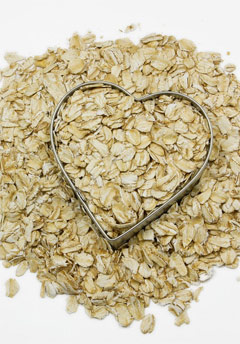 Freshly cooked oatmeal is the perfect way to start off your day, especially if
you are trying to prevent or are currently dealing with heart disease or
diabetes. Oats, oat bran, and oatmeal contain a specific type of fiber known as
beta-glucan. Since 1963, study after study has proven the beneficial effects of
this special fiber on cholesterol levels. Studies show that in individuals with
high cholesterol (above 220 mg/dl), consuming just 3 grams of soluble oat fiber
per day (an amount found in one bowl of oatmeal) typically lowers total
cholesterol by 8-23%. This is highly significant since each 1% drop in serum
cholesterol translates to a 2% decrease in the risk of developing heart disease.
High cholesterol levels correlate with the build up of plaques in blood vessel
walls. If these plaques become damaged or simply grow too large, they can
rupture, blocking a blood vessel and causing a heart attack, stroke, or blood
clots elsewhere in the body. Lowering high cholesterol levels can therefore
significantly reduce the risk of cardiovascular disease and stroke. Freshly cooked oatmeal is the perfect way to start off your day, especially if
you are trying to prevent or are currently dealing with heart disease or
diabetes. Oats, oat bran, and oatmeal contain a specific type of fiber known as
beta-glucan. Since 1963, study after study has proven the beneficial effects of
this special fiber on cholesterol levels. Studies show that in individuals with
high cholesterol (above 220 mg/dl), consuming just 3 grams of soluble oat fiber
per day (an amount found in one bowl of oatmeal) typically lowers total
cholesterol by 8-23%. This is highly significant since each 1% drop in serum
cholesterol translates to a 2% decrease in the risk of developing heart disease.
High cholesterol levels correlate with the build up of plaques in blood vessel
walls. If these plaques become damaged or simply grow too large, they can
rupture, blocking a blood vessel and causing a heart attack, stroke, or blood
clots elsewhere in the body. Lowering high cholesterol levels can therefore
significantly reduce the risk of cardiovascular disease and stroke.
A study published in the Archives of Internal Medicine confirms that eating high
fiber foods, such as oats, helps prevent heart disease. Almost 10,000 American
adults participated in this study and were followed for 19 years. People eating
the most fiber, 21 grams per day, had 12% less coronary heart disease (CHD) and
11% less cardiovascular disease (CVD) compared to those eating the least, 5
grams daily. Those eating the most water-soluble dietary fiber fared even better
with a 15% reduction in risk of CHD and a 10% risk reduction in CVD.
4) Oat Antioxidants Reduce Risk of Cardiovascular Disease
Oats, via their high fiber content, are already known to help remove cholesterol
from the digestive system that would otherwise end up in the bloodstream. Now,
the latest research suggests they may have another cardio-protective mechanism.
Antioxidant compounds unique to oats, called avenanthramides, help prevent free
radicals from damaging LDL cholesterol, thus reducing the risk of cardiovascular
disease, suggests a study conducted at Tufts University and published in The
Journal of Nutrition.
In this study, laboratory animals were fed saline containing 0.25 grams of
phenol-rich oat bran, after which blood samples were taken at intervals from 20
to 120 minutes. After 40 minutes, blood concentrations of avenanthramides had
peaked, showing these compounds were bioavailable (able to be absorbed).
Next, the researchers tested the antioxidant ability of avenanthramides to
protect LDL cholesterol against oxidation (free radical damage) induced by
copper. Not only did the avenanthramides increase the amount of time before LDL
became oxidized, but when vitamin C was added, the oat phenols interacted
synergistically with the vitamin, extending the time during which LDL was
protected from 137 to 216 minutes.
In another study also conducted at Tufts and published in Atherosclerosis,
researchers exposed human arterial wall cells to purified avenenthramides from
oats for 24 hours, and found that these oat phenols significantly suppressed the
production of several types of molecules involved in the attachment of monocytes
(immune cells in the bloodstream) to the arterial wall�the first step in the
development of atherosclerosis.
Oat avenanthamides suppressed production of ICAM-1 (intracellular adhesion
molecule-1) and VCAM-1 (vascular adhesion molecule-1), E-selectin, and the
secretion of pro-inflammatory cytokines KL-6, chemokines IL-8 and protein MCP-1
(monocyte chemoattractant protein). Our advice: Cut an orange (which is rich in
vitamin C) in quarters or pour yourself a glass of orange juice to enjoy along
with your oatmeal. If you prefer some other grain for your breakfast cereal, top
it with a heaping spoonful of oat bran.
5) Prevent Heart Failure
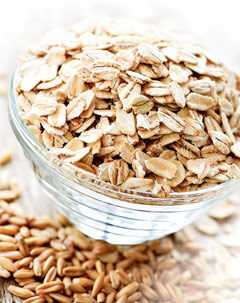 Heart failure is the leading cause of hospitalization among the elderly in the
United States. Success of drug treatment is only partial (ACE inhibitors and
beta-blockers are typically used; no evidence has found statins safe or
effective for heart failure), and its prognosis remains poor. Follow up of 2445
discharged hospital patients with heart failure revealed that 37.3% died during
the first year, and 78.5% died within 5 years. Arch Intern Med. 2007 Mar
12;167(5):490-6.;Eur Heart J. 2006 Mar;27(6):641-3. Heart failure is the leading cause of hospitalization among the elderly in the
United States. Success of drug treatment is only partial (ACE inhibitors and
beta-blockers are typically used; no evidence has found statins safe or
effective for heart failure), and its prognosis remains poor. Follow up of 2445
discharged hospital patients with heart failure revealed that 37.3% died during
the first year, and 78.5% died within 5 years. Arch Intern Med. 2007 Mar
12;167(5):490-6.;Eur Heart J. 2006 Mar;27(6):641-3.
Since consumption of whole grain products and dietary fiber has been shown to
reduce the risk of high blood pressure and heart attack, Harvard researchers
decided to look at the effects of cereal consumption on heart failure risk and
followed 21,376 participants in the Physicians Health Study over a period of
19.6 years. After adjusting for confounding factors (age, smoking, alcohol
consumption, vegetable consumption, use of vitamins, exercise, and history of
heart disease), they found that men who simply enjoyed a daily morning bowl of
whole grain (but not refined) cereal had a 29% lower risk of heart failure. Arch
Intern Med. 2007 Oct 22;167(19):2080-5. Isn't your heart worth protecting,
especially when the prescription�a morning bowl of hearty whole grains�is so
delicious? For quick, easy, heart-healthy, whole grain recipes, click The
World's Healthiest Foods, and look at the "How to Enjoy" section in any of our
grain profiles.
6) Enhance Immune Response to Infection
In laboratory studies reported in Surgery, beta-glucan significantly enhanced
the human immune system's response to bacterial infection. Beta-glucan not only
helps neutrophils (the most abundant type of non-specific immune cell) navigate
to the site of an infection more quickly, it also enhances their ability to
eliminate the bacteria they find there.
According to study leader Jonathan Reichner of the Department of Surgery at
Rhode Island Hospital and Brown University, priming neutrophils with beta-glucan
helps these immune defenders quickly locate the bacterial mother lode within
infected tissue. And this more rapid response to infection results in faster
microbial clearance and healing. Since our non-specific immune defenses are the
body's first strike forces against invading pathogens, starting your day with a
bowl of oatmeal may boost your immune response in addition to your morning
energy levels.
7) Stabilize Blood Sugar
Studies also show that beta-glucan has beneficial effects in diabetes as well.
Type 2 diabetes patients given foods high in this type of oat fiber or given
oatmeal or oat bran rich foods experienced much lower rises in blood sugar
compared to those who were given white rice or bread. Starting out your day with
a blood sugar stabilizing food such as oats may make it easier to keep blood
sugar levels under control the rest of the day, especially when the rest of your
day is also supported with nourishing fiber-rich foods.
8) Lower Type 2 Diabetes Risk
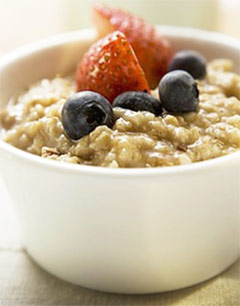 Oats and other whole grains are a rich source of magnesium, a mineral that acts
as a co-factor for more than 300 enzymes, including enzymes involved in the
body's use of glucose and insulin secretion. Oats and other whole grains are a rich source of magnesium, a mineral that acts
as a co-factor for more than 300 enzymes, including enzymes involved in the
body's use of glucose and insulin secretion.
The FDA permits foods that contain at least 51% whole grains by weight (and are
also low in fat, saturated fat, and cholesterol) to display a health claim
stating consumption is linked to lower risk of heart disease and certain
cancers. Now, research suggests regular consumption of whole grains also reduces
risk of type 2 diabetes. (van Dam RM, Hu FB, Diabetes Care).
In this 8-year trial, involving 41,186 particpants of the Black Women's Health
Study, research data confirmed inverse associations between magnesium, calcium
and major food sources in relation to type 2 diabetes that had already been
reported in predominantly white populations.
Risk of type 2 diabetes was 31% lower in black women who frequently ate whole
grains compared to those eating the least of these magnesium-rich foods. When
the women's dietary intake of magnesium intake was considered by itself, a
beneficial, but lesser�19%�reduction in risk of type 2 diabetes was found,
indicating that whole grains offer special benefits in promoting healthy blood
sugar control. Daily consumption of low-fat dairy foods was also helpful,
lowering risk of type 2 diabetes by 13%. Enjoy a hearty breakfast and get the
benefits of both oats and dairy by serving hot oatmeal, spiced with cinnamon,
and topped with handful of walnuts and low-fat milk.
9) Protective against Childhood Asthma
According to the American Lung Association, almost 20 million Americans suffer
from asthma, which is reported to be responsible for over 14 million lost school
days in children, and an annual economic cost of more than $16.1 billion.
Increasing consumption of whole grains and fish could reduce the risk of
childhood asthma by about 50%, suggests the International Study on Allergy and
Asthma in Childhood (Tabak C, Wijga AH, Thorax).
The researchers, from the Dutch National Institute of Public Health and the
Environment, Utrecht University, University Medical Center Groningen, used food
frequency questionnaires completed by the parents of 598 Dutch children aged
8-13 years. They assessed the children's consumption of a range of foods
including fish, fruits, vegetables, dairy and whole grain products. Data on
asthma and wheezing were also assessed using medical tests as well as
questionnaires.
While no association between asthma and intake of fruits, vegetables, and dairy
products was found (a result at odds with other studies that have supported a
link between antioxidant intake, particularly vitamins C and E, and asthma), the
children's intake of both whole grains and fish was significantly linked to
incidence of wheezing and current asthma.
In children with a low intake of fish and whole grains, the prevalence of
wheezing was almost 20%, but was only 4.2% in children with a high intake of
both foods. Low intake of fish and whole grains also correlated with a much
higher incidence of current asthma (16.7%). compared to only a 2.8% incidence of
current asthma among children with a high intake of both foods.
After adjusting results for possible confounding factors, such as the
educational level of the mother, and total energy intake, high intakes of whole
grains and fish were found to be associated with a 54 and 66% reduction in the
probability of being asthmatic, respectively.
The probability of having asthma with bronchial hyperresponsiveness (BHR),
defined as having an increased sensitivity to factors that cause narrowing of
the airways, was reduced by 72 and 88% when children had a high-intake of whole
grains and fish, respectively. Lead researcher, CoraTabak commented, "The rise
in the prevalence of asthma in western societies may be related to changed
dietary habits." We agree. The Standard American Diet is sorely deficient in the
numerous anti-inflammatory compounds found in fish and whole grains, notably,
the omega-3 fats supplied by cold water fish and the magnesium and vitamin E
provided by whole grains. One caution: wheat may need to be avoided as it is a
common food allergen associated with asthma.
10)Protect against Heart Disease
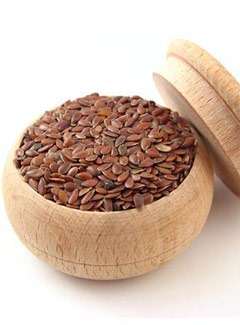 One type of phytochemical especially abundant in whole grains including oats are
plant lignans, which are converted by friendly flora in our intestines into
mammalian lignans, including one called enterolactone that is thought to protect
against breast and other hormone-dependent cancers as well as heart disease. In
addition to whole grains, nuts, seeds and berries are rich sources of plant
lignans, and vegetables, fruits, and beverages such as coffee, tea and wine also
contain some. When blood levels of enterolactone were measured in over 800
postmenopausal women in a Danish study published in the Journal of Nutrition,
women eating the most whole grains were found to have significantly higher blood
levels of this protective lignan. Women who ate more cabbage and leafy
vegetables also had higher enterolactone levels. One type of phytochemical especially abundant in whole grains including oats are
plant lignans, which are converted by friendly flora in our intestines into
mammalian lignans, including one called enterolactone that is thought to protect
against breast and other hormone-dependent cancers as well as heart disease. In
addition to whole grains, nuts, seeds and berries are rich sources of plant
lignans, and vegetables, fruits, and beverages such as coffee, tea and wine also
contain some. When blood levels of enterolactone were measured in over 800
postmenopausal women in a Danish study published in the Journal of Nutrition,
women eating the most whole grains were found to have significantly higher blood
levels of this protective lignan. Women who ate more cabbage and leafy
vegetables also had higher enterolactone levels.
11) Wheat Alternative for women with Celiac Disease
Although treatment of celiac disease has been thought to require lifelong
avoidance of the protein gluten, which is found in wheat, rye, barley and oats,
recent studies of adults have shown that oats, despite the small amount of
gluten they contain, are well-tolerated. Now, a double blind, multi-center study
involving 8 clinics treating 116 children newly diagnosed celiac disease
suggests oats are a good grain choice for children with celiac disease as well.
The children were randomly assigned to receive either the standard gluten-free
diet (no wheat, barley, rye or oats) or a gluten-free diet with some wheat-free
oat products. At the end of the study, which ran for a year, all the children
were doing well, and in both groups, the mucosal lining of the small bowel
(which is damaged by wheat gluten in celiac disease) had healed and the immune
system (which is excessively reactive in celiac patients) had returned to
normal.
12) Boost Nutrition profile of gluten free diets
Two recent studies out of Scandinavia show that adding oats to a gluten-free
diet may enhance the nutritional values of the diets, particularly for vitamins
and minerals, as well as increasing antioxidant levels. Researchers asked 13 men
and 18 women with Celiac disease to follow a gluten-free diet with the addition
of kilned (stabilized) or unkilned oats. After six months, the addition of
stabilized oats resulted in an increased intake of vitamin B1 and magnesium,
while the unkilned oats increased intakes of magnesium and zinc. In the second
study from Scandinavia, the addition of gluten-free oats allowed people on
gluten-free diets to achieve their recommended daily intakes of fiber, as well
as increasing levels of a particular antioxidant called bilirubin, which helps
the body eliminate free radicals as well as protect the brain from oxidative
damage. ( European Journal of Clinical Nutrition, January 2010; 64:62-67,
doi:10.1038/ejcn.2009.113).
13) Increase appetite control hormones
Australian researchers studied fourteen people who ate a control meal and three
different cereals with different levels of oat beta glucan. They then collected
blood samples for four hours after each meal, and found a significant dose
response between higher levels of oat beta glucan and higher levels of Peptide
Y-Y, a hormone associated with appetite control. ( Nutrition Research, October
2009; 29(10):705-9 )
14) Oat beta glucans improve immune system defenses
Italian researchers reviewed existing research about the positive effects of
beta glucans on human health. They found that, in addition to reducing
cholesterol and blunting glycemic and insulin response, beta glucans boost
defenses of the immune system agains bacteria, viruses, fungi, and parasites. (
Minerva Medica, June 2009; 100(3):237-45 )
15)
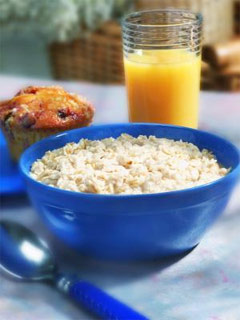 Help cut the use of Laxatives Help cut the use of Laxatives
Laxative use, especially among the elderly in nursing homes, can lead to
malnutrition and unwanted weight loss. Viennese researchers studied 30 frail
nursing-home residents in a controlled, blind, intervention trial where 15
patients received 7-8g of oat bran per day. At the end of 6 weeks, 59% of the
oat group had discontinued laxative use while maintaining body weight; the
control group showed an 8% increase in laxative use and a decrease in body
weight.
( Journal of Nutrition, Health, and Aging, February 2009; 13(2):136-9 )
16) May improve Insulin sensitivity
Researchers in Chicago carried out a randomized, double-blind, controlled
clinical trial of ninety-seven men and women, in which half of the group
consumed foods containing oat beta-glucan, while the other half ate control
foods. At the end of the trial period, the oat group showed improvements in
insulin sensitivity, while the control group was unchanged.
( European Journal of Clinical Nutrition, June 2007; 61(6):786-95 )
17) OATS #3 overall, #1 For breakfast in Satiety Index
In Australia, researchers at the University of Sydney fed 38 different foods,
one by one, to 11-13 different people, then asked them to report their �satiety�
or fullness every 15 minutes for the next two hours. From this, they ranked all
38 foods in a �Satiety Index.� Oatmeal rated #3 overall for making people feel
satisfied and full, and it rated #1 in the breakfast food group. ( European
Journal of Clinical Nutrition, September 1995; 49(9): 675-90 ).
Eating oats in your diet provides a wide range of important health benefits.
Oatmeal and oat bran are significant sources of dietary fiber. This fiber
contains a mixture of about half soluble and half insoluble fibers.
Dated 17 December 2013
|
|
|
|
|









